1-in-1 is a like a mini hack day, but I find it refreshing that it is without prizes or even formal presentations. The goal is to complete a whole project in one day. You’re advised to not stretch too far or try to learn some huge new skill set. This is the full list of what everyone is working on today.
I am starting on a new project that I wanted to do since I learned about Sing-a-ma-jigs, a singing children’s toy. They aren’t very big in the UK, so when I was back in the US for Thanksgiving last year, we bought a couple (the red and purple in the photo, I found the white one at Goodwill yesterday).
Their big draw is that they sing with each other and harmonize. We were then very sad to find that they don’t actually communicate with each other. Some mildly clever music theory (arpeggios from the same key) are used to ensure that multiple toys sound good together. It does result in a lot of very satisfying perfect cadences.
What I would like to do at the ITP Camp is develop toys that do actually communicate with each to spontaneous create harmony. I haven’t worked out the details yet, but the first step is to mimic the original toy with my own prototype that can be improved upon. So today, I am building a bee #, a singing bee. Below is the Bee in all his glory before he finds his voice.
So first, breakfast was consumed. It involved a square bagel.
Then I began working out a simple prototype circuit. I’m using an Arduino and basically building off this tutorial. I wanted to use the Adafruit Waveshield, but I did a poor job preparing and didn’t realize the opamp and dac were missing from the kit. This is the circuit.
I then began performing a delicate surgery on Bee. I cut out a hole in his face slightly smaller than the speaker.
Then I crocheted a single crochet chain around the opening by cutting little holes around the edge and picking up stitches.
I ended up threading yarn into the crochet to create a drawstring to tighten the opening.
When I went to Goodwill yesterday to find a stuffed toy that I could cut up, I found the white sing-a-ma-jig. I was initially very happy that I had a trio, but when I got it home with my other two, it didn’t harmonize. It sounded awful with them. It also operated slightly differently – it started in the song mode when first turned on, unlike the other two which start in the harmony mode. Today I recorded each one individually and used Sonic Visualiser to analyze the audio. I figured out the keys for each one and it’s now very clear why they don’t work together: the red and purple are in D Flat Major and the white one in is B Major.
So I now know the key my Bee needs to be in to harmonize with each sing-a-ma-jig, and unlike the sing-a-ma-jigs, it’s flexible and can change.
The code is available here.
Bee # from Becky Stewart on Vimeo.


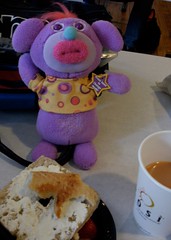
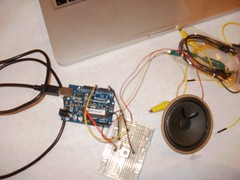
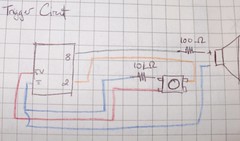

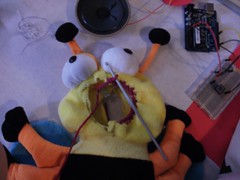

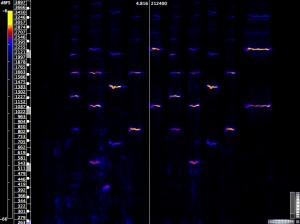
Pingback: Bee # « ITP Camp 2011